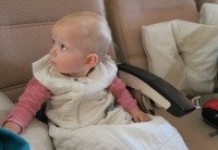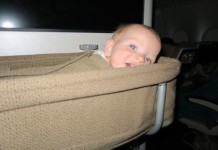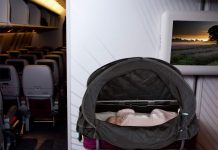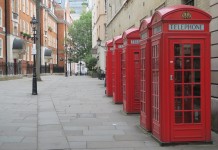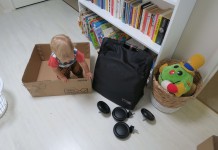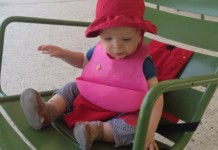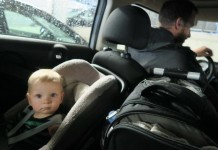The world of travel cots is hugely confusing, and often expensive. So which is the best travel cot for you?
What’s the best travel cot for infrequent travellers?
If you won’t be travelling very often, only plan on having one child, and often visit the same place (i.e. just the occasional long weekend with the grandparents), buy any old travel cot. That way you can leave it at the grandparents place or simply remember when you’re struggling to set it up or lug it around that you saved a lot of money for just that reason. It’s a good solution for infrequent travellers!
What’s the best travel cot for frequent (or fussy!) travellers.
If you’re a frequent traveller, planning on having more than one child so you think you get lots of use out of the travel cot, or simply can’t bear the thought of a crappy “make do” option, then it’s worth upping the ante a little on travel cots.
Before you consider the options, remember that like prams, it’s frustratingly difficult to get every single thing you want out of a travel cot. Usually you will have to pick and choose which features are most important to you.
Of all the travel cots currently on the market, the two we favour are the Baby Bjorn (which Sue considers the Rolls Royce of travel cots – pictured above, and yes, it’s priced accordingly), and the Phil & Teds traveller. If you are travelling with a very small baby – ie: one who is still sleeping in a bassinette at home, the Phil and Teds nest is a lovely option for the first 3-6 months.
Compare our two favourite travel cots:
Review of the Baby Bjorn travel cot light versus the Phil and Teds traveller
Baby Bjorn travel cot light – PROS:
It is so easy to put up. No, really, soooo easy. You can do it in under a minute, and pack it away in just slightly more. (In fact, in an addition that may be too much information for some – yet reassuring for others – Sue recently put this up while breastfeeding. It’s that easy.)
Also, it seems like a really good bed. The mattress looks and feel good, you can easily attach sheets, and there’s a bit of space between the base and the ground, which is better for both comfort and warmth.
This is the travel cot we recommend if you were going to be away for a while, and mostly staying in one place, because it’s the travel cot we feel is most like a proper bed. If Sue had to name ONE cot as the best travel cot, this would likely be it.
Baby Bjorn travel cot light – CONS:
It’s expensive. It’s basically the most expensive travel cot around. You can buy them second-hand, but be quick, and don’t expect to save a whole lot.
It’s bulkier than the Phil and Teds. Sure, the Baby Bjorn travel cot packs into its own case, and it IS quite light – but that case takes up space. We wouldn’t use it on a trip where you had to lug luggage around; this is a cot to take on a car trip, or on a plane trip if you’re going straight from the airport into a rental car. If your trip involves public transport, leave the Baby Bjorn travel cot at home.
Phil & Teds traveller – PROS:
It’s light. Really, really light.
It packs up small. Theoretically, this could fit in a suitcase. In reality Sue’s suitcase is always too full to even shove in an extra nappy, let alone a cot (even a compact one) – but she’s working on it.
The Phil and Teds traveller comes with a handy zip down side and an even handier built-in net top, perfect if you’re travelling somewhere where there’s mosquitoes. (You don’t have to use the net if you don’t need to.)
While it’s still not cheap, it’s a fair chunk cheaper than the Baby Bjorn. Maybe $100 cheaper. For many people, the combination of all these ‘pros’ makes it the best travel cot option. And overall, we DO like it an awful lot.
Phil & Teds traveller – CONS:
It’s not super easy to set up. At least, not until you practice a bit. But by “a bit” we mean practice every day for a week, then you’ll have it down pat. (That may sound dumb, but remember you’re going to be putting this thing up under far from ideal conditions; jetlagged, or with a small baby crawling all over you trying to “help”.)
Getting it back into the bag takes a packing maestro. Seriously, this is a pain. It’s like the bag is 30% too small. (Yes it could be that Sue is always 30% too tired to pack it down tight enough, but even then, the designers should have factored that in – she can’t be the only one.)
The mattress situation is far from ideal. Basically, the blow up style mattress slides into a plastic insert that forms the base of the cot. This means your baby is sleeping pretty much touching the floor (we usually shove a couple of blankets under the outside base of the cot for insulation and padding), and if you don’t do our mattress hack suggested below, your child will be sleeping on a slippery plastic surface. Don’t get us wrong, we love this cot, but only when it’s customised and when you’re used to putting it up.
Phil & Teds traveller cot mattress hack.
I’m not sure why the designers decided parents will be comfortable with their baby sleeping on a plastic surface. To combat this, we took the blow up mattress, and sewed a home-made ‘pillowcase’ tightly around the whole thing. Then, rather than sliding the mattress into the insert, we rest it on top. That way, the baby is sleeping on normal cotton sheets (far quieter when they incessantly roll over, and less sweaty than plastic.)
We understand that the new Phil and Teds traveller cots have been modified so that the mattress is in a cover, which then sits in the cot, similar to the cot mattress hack described above. If you’re looking at buying one of the older models though, you’ll want to consider doing the hack we suggest.

